Hyperlinks
Updated for Logos 8+
Page Contents
What are Hyperlinks?
Creating hyperlinks
The Anatomy of a Link
Security Warnings in MS Office Windows
What are Hyperlinks?
- Hyperlinks are code that can be embedded in text and it instructs Logos and other applications to navigate to a specific place within a book, or to open a file, a web page, etc.
- Logos can format hyperlink code for URL (in email or web page), HTML (in raw HTML), L4 (direct link), Wiki (in a Logos wiki), and RL (for Logos Reading Lists).
- URL, HTML, Wiki, and RL use ref.ly that works with many external applications and the web.
- ref.ly require an internet connection as it opens the Web App before opening Logos; but
- Logos can use ref.ly without an internet connection
- L4 works within Logos and some external apps like Word, Powerpoint (in Windows).
- You can create links to:
- Resources
- Searches
- Guides
- your Documents
- Collections
- Tools like Factbook and Copy Bible Verses
- web pages
- files on your computer
Creating hyperlinks
Open a panel menu. If you see “Copy Location as:” then you can create a hyperlink:
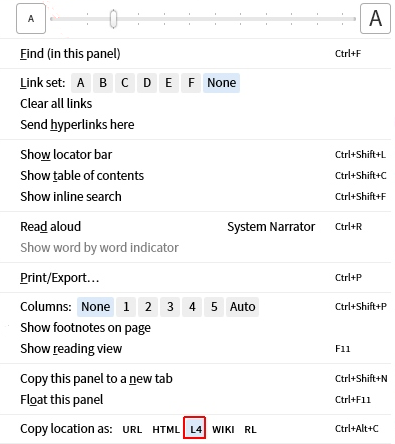
Choose L4 for local use and use Ctl+Alt+C to copy the link to your clipboard.
Otherwise, copy the URL for a web page or copy the full path to a file on your computer.
Links in Clippings and Notes documents
For internal hyperlinks:
- use Ctl+Alt+C to get the link (L4) for this lemma in a lexicon.
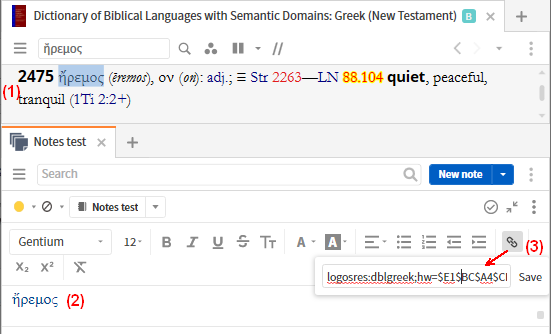
- Select the Greek word that you previously pasted into a Note.
- Paste the link (CTRL+V) into the Link box and Save it.
- The word is now a hyperlink.
For external hyperlinks:
- Copy the web page URL or the full path to a local file.
- Select the text in your document
- Paste the link into the Link or Address box.
Links in MS Word documents or Powerpoint slides (L4)
Copy the L4 link as above.
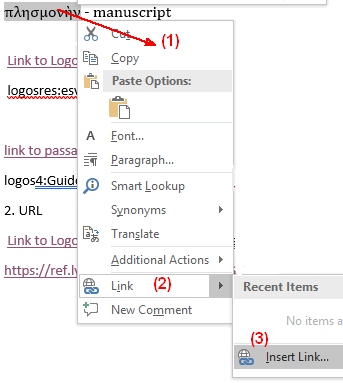
- Select the word(s) in the document and right click.
- Select Link in the menu, then click the little arrow
- Click Insert Link...
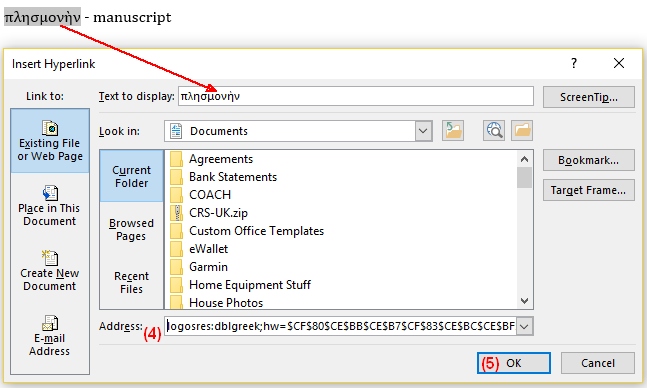
- Paste the link (CTRL+V) into the Address box.
- Click OK.
Links in MS Word documents or Powerpoint slides (URL)
Copy the link using the URL option.
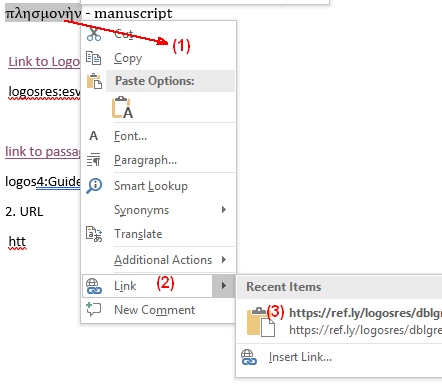
- Select the word(s) in the document and right click.
- Select Link in the menu, then click the little arrow
- The ref.ly URL was recognised from the clipboard:
Click to finish!
Links in Personal Books
The Wiki option provides the formatting for a wiki article and it can be used in a Personal book (PB). For example:
- The Wiki link address for our bible reference is [[John 1:1 >> https://ref.ly/logosres/esv?ref=BibleESV.Jn1.1]]
- It will be displayed in the compiled PB as a link with the label John 1:1.
- Clicking the above link will go thru the Logos Web App as the implementation in a Personal Book can’t be demonstrated from this web-based wiki article.
In practice it is better to embed the L4 link i.e. [[label >> L4 link address]], especially when dealing with non-bible datatypes. For example:
- The L4 link address for our bible reference is logosres:esv;ref=BibleESV.Jn1.1
- The formatting for the PB becomes [[John 1:1 >> logosres:esv;ref=BibleESV.Jn1.1]]
- It will be displayed in the compiled PB as a link with the label John 1:1
- Clicking the above link will take you directly to Logos, as will the PB. It also simulates the above ref.ly address in the PB.
Note: to access your preferred bible use [[John 1:1 >> BibleESV: Jn 1.1]] or just type the reference John 1:1.
The Anatomy of a Link
Understanding the components of a hyperlink are will allow you to customize links or create them from scratch.
Bible links
Preferred resource
The location options L4 and URL are resource specific, but there are protocols that are resource independent.
logosref:Bible.Jn1.1
- logosref – hyperlink protocol for a datatype
- Bible – the generic Bible datatype
- External apps and web pages will open your preferred bible in Logos
https://ref.ly/logosref/Bible.Jn1.1
- ref.ly – URL shortener for references
- logosref – hyperlink protocol for a datatype
- Bible – the generic Bible datatype
- External apps and web pages will open your preferred bible in Logos via the Web App.
https://ref.ly/Jn1.1
- The “original” shortened bible reference (see https://ref.ly)
- External apps and web pages will open Biblia.com.
Within Logos, however, you can type bible references directly into your note, clipping, personal book etc. If it isn’t recognised then:
- Note/Clipping: select the reference and type a properly formatted reference in the Link or Address box (Ctrl+K)!
- Personal Book: use wiki formatting e.g. [[Jo 2:3 >> Bible:Jn 2:3]] where Jo 2:3 is used in the context of the book of John.
Other datatype links
These are not as straightforward especially when it comes to the value e.g. lemmas, Greek headwords.
Security Warnings in MS Office (Windows)
The default security settings in Office 2007 and later will warn you that the L4 hyperlink could pose a security risk when you click on a link. This behavior can be stopped by a registry edit. Microsoft has instructions for this at http://support.microsoft.com/kb/925757.
Note: the manual method works for the latest version(s) of Office if you use the highest version in your registry e.g. Office\16.0.